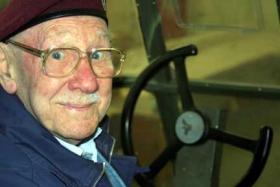Bert was born in Aberystwyth, Wales (on the coast of Cardigan Bay) in 1918. He went to school there at Aberystwyth before joining a shoe firm in 1934 when he left school. In 1937 he was transferred to London where he worked there until war broke out in 1939.
Bert registered for service and asked to join the RAF but was called up in the Army and found himself in the Army Medical Corps. Early the following year, in March 1940 he married Gladys at the church in the Royal Naval Hospital, Haslar, Gosport where she was cook to the Surgeon Rear Admiral.
Shortly afterwards, he was sent to France and was part of the British Expeditionary Force deployed in Belgium when the German Army invaded. Bert was eventually evacuated from Dunkirk.
The following year, in 1941 Bert reapplied as the RAF asked for Army volunteers to train as pilots and was accepted. Whilst he awaited transfer however, the Army cancelled transfers and instead asked whether he would like to join the newly formed Glider Pilot Regiment. After initial training he went to flying school, first on powered aircraft in Tiger Moths and Magisters, before learning to fly gliders. In early 1943, he finally gained his Wings. He then joined A Squadron and later that year was shipped out to Algeria and Tunisia. Scheduled to take part in the Sicily operations, Bert’s transport reached Africa too late to take part (something he was later quite thankful about).
Bert returned to the UK, and had transferred to E Squadron to train for "D Day". After intensive training, he finally flew in to action in the evening of 6 June 1944 carrying a full load of troops of the Royal Ulster Rifles of the 6th Air Landing Brigade flying a Horsa, behind a Dakota tug. After a successful landing, he returned to the UK shortly afterwards and beginning preparations for his next operation.
Further planned insertions to the Normandy area were cancelled as events moved more quickly than expected. He flew to Arnhem, for the impending Battle of Arnhem on 17 September 1944. He was one of the few who was able to escape across the Rhine from the Battle.
Returning to the UK, he transferred to C Squadron and learnt to fly Hamilcars. As he trained from Tarrant Rushden in February 1945, he received the Commander in Chief’s Certificate of Gallantry for his service in Arnhem.
On 24 March 1945, SSgt Harget flew on Operation Varsity, the Rhine Crossing to Wesel. He flew a Hamilcar carrying a 17 pounder gun and crew of the Royal Artillery. It proved his most difficult landing.
Due to the dense smoke near the landing zones, he was unable to see the ground until the last moment. Landing successfully, he found that he had landed in the wrong place and his glider was surrounded by German forces. He was captured on the 25 March 1945 - his fifth Wedding Anniversary. As the war in Europe was drawing to a close however, he was only a prisoner for seven weeks being liberated by advancing Russian forces in Rostock on the Baltic Sea coast.
When the war in Europe ended in May 1945, Bert was repatriated to England. The war in the Far East was still in progress however, and he rejoined the Regiment. He was put on standby for the planned actions in the Far East. Once again, events accelerated faster than expected and the surrender of Japan in August 1945.
Staff Sergeant Harget was finally demobilized in May 1946.
Bert passed away on 12 March 2015.



Latest Comments
There are currently no comments for this content.
Add Comment
In order to add comments you must be registered with ParaData.
If you are currently a ParaData member please login.
If you are not currently a ParaData member but wish to get involved please register.